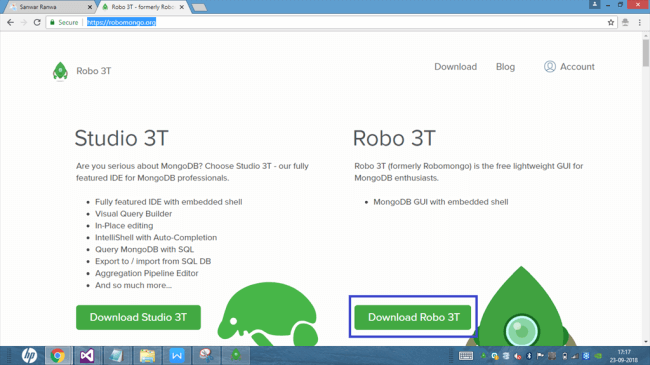

Use a Schema Editor to create a schema definition file in JSON format for your MongoDB.įor more information, see this article about
ROBO 3T TO CONNECT LOCAL MONGODB DRIVER
Local Metadata File: Enter the full path of a local JSON file containing the schemaĭefinition that you want the driver to use when connecting to MongoDB.The driver samples every second record in the database. For example, if you set this property to 2, then Through the database to generate a temporary schema definition. Sampling Interval: Enter the interval at which the driver samples records when scanning.When this property is set to 0, the driver samples every document in the database. Sampling Count: Enter the maximum number of records that the driver can sample to generate a.Sampling Method: This property specifies whether the driver starts sampling data from the first or last record when generating a temporary schema definition.įorward: The driver samples data starting from the first record in the database, then samples the next record, and so on.īackwards: The driver samples data starting from the last record in the database, then samples the preceding record, and so on. Metadata File: The driver loads the schema definition from the JSON file specified in the Local File field or the LocalMetadataFile key Metadata Mechanism: This option specifies where the driver looks for the schema definition.ĭatabase: The driver loads the schema definition from the MongoDB database.
ROBO 3T TO CONNECT LOCAL MONGODB PASSWORD
Trust Store Password: Enter the password property to your password for accessing the TrustStore. opt/sisense/storage/connectors/files/keystore.jks Trust Store: Enter the full path of the Trust Store. Authentication Source: To use a database other than the admin database to check your credentials, enter the name of the database.

Password: Enter your password to access your MongoDB.Username: Enter your username to access your MongoDB.Replica Set: If you are connecting to a replica set in your MongoDB implementation, select the Replica Set checkbox and enter the name of the replica set (required field).Īuthentication Mechanism: The authentication mechanism to use, No authentication, LDAP, or username and password. Port: Enter the number of the TCP port that the server uses to listen for client connections.ĭatabase: Enter the name of the database that you want to access (case-sensitive). Location: Enter IP address of the host where your MongoDB instance is running. In the MongoDB settings area, enter the following information: You can connect to MongoDB using either Basic settings entering the required parameters or by using Advanced settings via a connection string. The Add Data dialog box is displayed.Ĭlick MongoDB to open the MongoDB settings. In the Data page, open a ElastiCube or create a new ElastiCube.For a non-local installation, open Sisense on the hosted cloud environment. Tables may be flattened with additional tables being created for nested items. Before connecting to MongoDB database with Sisense, note that MongoDB is an unstructured database, and therefore


 0 kommentar(er)
0 kommentar(er)
